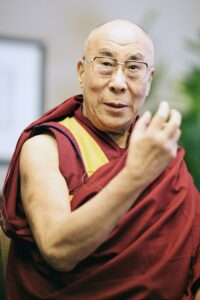Dalai Lama Biography and Works.

His holiness, the 14th Papai Lal leader of the Tibe Gyatso, is Tibet’s head of state as well as the spiritual leader of the Tibetan people.
The Dalai Lama was born in Taktser, Qinghai, and was selected as the rebirth of the 13th Dalai Lama, two years later, although he was only formally recognized as the 14th on the November 17, 1950, at the age of 15.
He inherited control over a government controlling area roughly corresponding to the Tibet Autonomous Region just as the nascent People’s Republic of China wished to reassert central control over it. There is a dispute over whether the respective governments reached an agreement for a joint Communist-Lamaist administration.
His Holiness assumed full power of Tibet in November 1950. He completed his ‘Doctorate of Buddhist Philosophy’ in 1959, the same year when China attacked Tibet, after which he escaped to Dharamsala, India, from where he has since then led the Tibetan government in exile.
On December 10, 1989, His Holiness accepted the Nobel Peace Prize on behalf of the oppressed everywhere and all those, who struggle for freedom and work for world peace and the people of Tibet’. In his acceptance statement, he declared, ‘This prize reaffirms our conviction that with truth, courage, and determination as our weapons, Tibet will be liberated. Our struggle must remain non-violent and free of hatred’.
Trivia
Tenzin was awarded the Christmas Humphreys Award from the Buddhist Society of the United Kingdom on May 28, 2004.
Quote
“Be kind whenever possible. It is always possible.”
- What is meant by Database Management System?
- Discuss the advantages and drawbacks of database.
- What do you mean by database ? Discuss its Characteristics.
- What is Data Mining?
- What are the conditions of communication?
- What do you mean by business communication ?
- organization / Differentiate between classical and modern theory of organization
- What is forecasting






